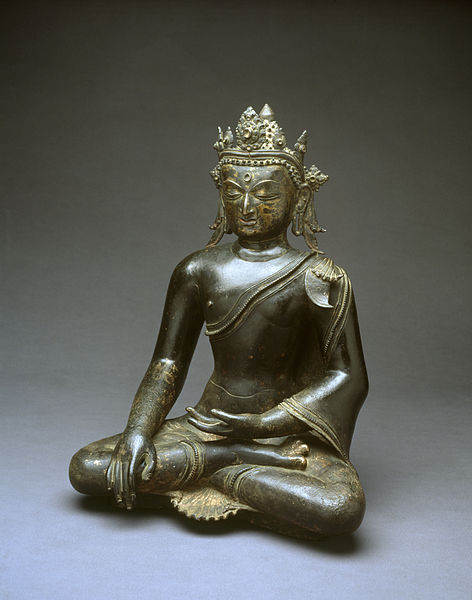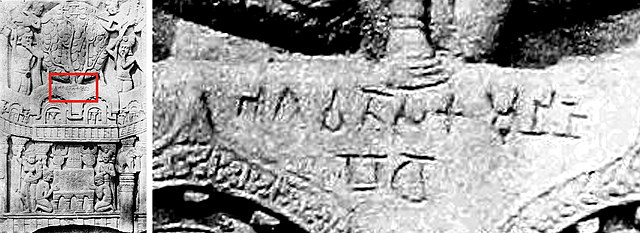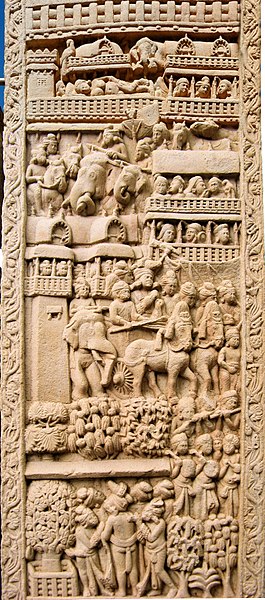
| SHAKYA
Gautam Buddh, called Shakyamuni "Sage of the Shakyas", the most famous Shakya. Seated bronze from Tibet, 11th century
Varn : Kshatriya
The Shakya (Pali in the Brahmi script Sakya, Sakiya, or Sakka, Sanskrit: Sakya) were a clan of Iron age India (1st millennium BCE), habitating an area in Greater Magadh, situated at present-day southern Nepal and northern India, near the Himalaya. The Shakyas formed an independent oligarchic republican state known as Sakya Ganrajya. Its capital was Kapilvastu, which may have been located either in present-day Tilaurakot, Nepal or present-day Piprahwa, India.
Gautam Buddh (c. 6th to 4th centuries BCE), whose teachings became the foundation of Buddhism, was the best-known Shakya. He was known in his lifetime as "Siddharth Gautam" and "Shakyamuni" (Sage of the Shakyas). He was the son of Suddhodan, the elected leader of the Sakya Ganarajya.
Etymology
:
Origins
:
This is confirmed by the Ambattha Sutta, where the Sakyans are said to be "rough-spoken", "of menial origin" and criticised because "they do not honour, respect, esteem, revere or pay homage to Brahmans." Some of the non-Vedic practices of this tribe included incest (marrying their sisters), the worship of trees, tree spirits and nags.
Munda
ancestors :
Scythian
Sakas :
History :
The
words "Bu-dhe" and "Sa-kya-mu-ni" (Sage of the
"Shakyas") in Brahmi script, on Ashoka's Rummindei Minor
Pillar Edict (circa 250 BCE).
There lived once upon a time a king of the Sakya, a scion of the solar race, whose name was Suddhodana. He was pure in conduct and beloved of the Sakya like the autumn moon. He had a wife, splendid, beautiful, and steadfast, who was called the Great Maya, from her resemblance to Maya the Goddess.
— Buddhacarita of Asvaghosa, I.1–2
Bharhut inscription: Bhagavato Sakamunino Bodho ("The illumination of the Blessed Sakamuni"), circa 100 BCE Buddhaghosa's work (II, 1–24) traces the origin of the Shakyas to king Ikshvaku and gives their genealogy from Maha Sammat, an ancestor of Ikshvaku. This list comprises the names of a number of prominent kings of the Ikshvaku dynasty, which include Mandhat and Sagar. According to this text, Okkamukh was the eldest son of Ikshvaku.
Sivisamjay and Sihassar were the son and grandson of Okkamukh. King Sihassar had eighty-two thousand sons and grandsons, who were together known as the Shakyas. The youngest son of Sihassar was Jaysen. Jaysen had a son, Sihahanu, and a daughter, Yashodhar (not to be confused with Prince Siddharth's wife), who was married to Devdahasakk.
Devdahasakk had two daughters, Anjana and Kaccana. Sihahanu married Kaccana, and they had five sons and two daughters; Suddhodan was one of them. Suddhodan had two queens, Maya and Prajapati, both daughters of Anjana. Siddharth (Gautam Buddh) was the son of Suddhodan and Maya. Rahul was the son of Siddharth and Yashodar (also known as Bhaddakaccana), daughter of Suppabuddh and granddaughter of Añjana.
Pali canon traces Gautam gotra (patriline) of Shakya to Rigvedic sage Angiras.
Map of mahajanpads with the Shakya Republic next to Shravasti and Koshal
Shakya administration :
According to the Mahavastu and the Lalitavistara Sutra, the seat of the Shakya administration was the santhagar ("assembly hall") at Kapilavastu. A new building for the Shakya santhagar was constructed at the time of Gautam Buddh, which was inaugurated by him. The highest administrative authority was the sidharth, comprising 500 members, which met in the santhagara to transact any important business. The Shakya Parishad was headed by an elected raja, who presided over the meetings.
By the time of Siddharta's birth, the Shakya republic had become a vassal state of the larger Kingdom of Koshal. The raja, once chosen, would only take office upon the approval of the King of Koshal. While the raja must have held considerable authority in the Shakya homeland, backed by the power of the King of Koshal, he did not rule autocratically. Questions of consequence were debated in the santhagar, in which, though open to all, only members of the warrior class ("rajan") were permitted to speak. Rather than a majority vote, decisions were made by consensus.
Annexation
by Koshl :
Religion :
Procession of king Suddhodan from Kapilavastu, proceeding to meet his son the Buddh walking in mid-air (heads raised towards his path at the bottom of the panel), and to give him a Banyan tree (bottom left corner). Sanchi.
Ashok's
Mahabodhi Temple and Diamond throne in Bodh Gaya, built circa 250
BCE. The inscription between the Chaitya arches reads: "Bhagavato
Sakamunino/ bodho" ie "The building round the Bodhi tree
of the Holy Sakamuni (Shakyamuni)". Bharhut frieze (circa 100
BCE).
Purportedly, many Shakyans joined people from other regions and became followers of the Buddh during his lifetime, and many young Shakyan men left their homes to become monastics.
Descents
:
According to Hmannan Yazawin, first published in 1823, the legendary king Abhiyaza, who founded the Tagaung Kingdom and the Burmese monarchy belonged to the same Shakya clan of the Buddh. He migrated to present-day Burma after the annexation of the Shakya kingdom by Koshal. The earlier Burmese accounts stated that he was a descendant of Pyusawhti, son of a solar spirit and a dragon princess.
Source :
https://en.wikipedia.org/ |



.jpg)

